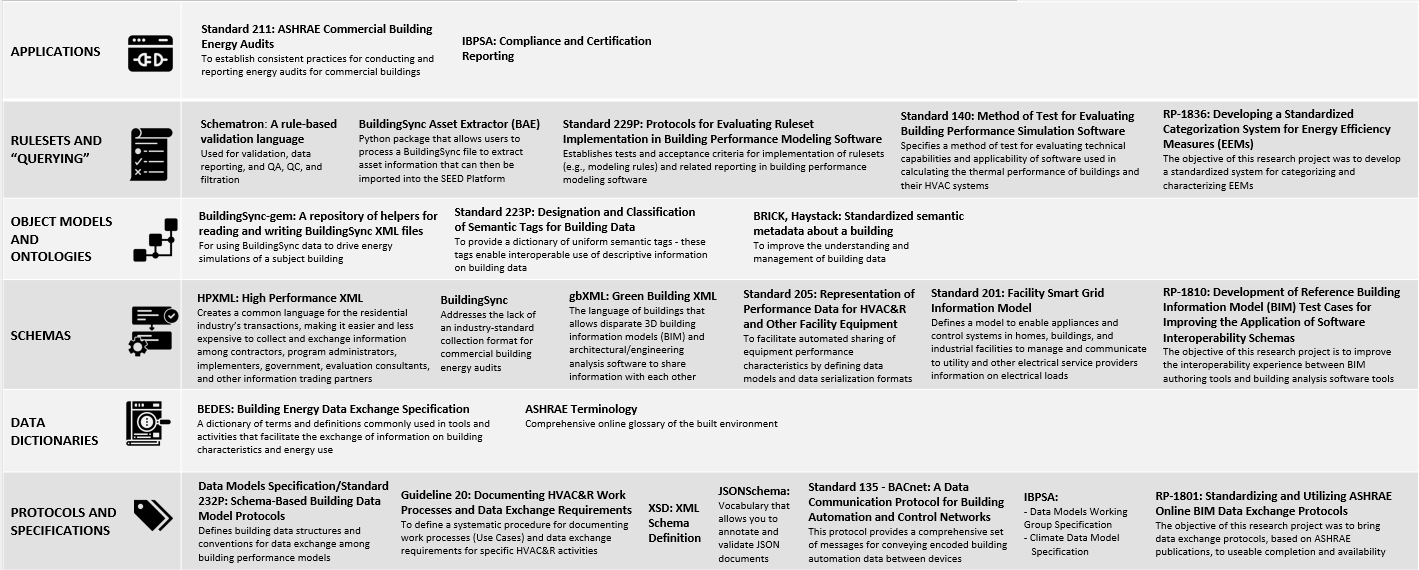Purpose
The purpose of data.ashrae.org is to serve as a repository for publicly available deliverables
from ASHRAE standards and research projects. These deliverables include report documents, XML
files, CAD files, test case documents,
software code, and much more.
The following visualization illustrates how the included standards, guidelines, research
projects, etc., are related within ASHRAE or ASHRAE-adjacent:

List of Available ASHRAE Standards and Research Projects
ASHRAE/IBPSA Standard 209, "Building Performance Simulation Process": This standard
establishes minimum requirements for the process of using simulation to evaluate building
performance and inform decision making. It applies to the use of building performance
simulation, including energy modeling, during the design, construction, and operation of new
buildings or major renovations of, or additions to, existing buildings.
ASHRAE/IBPSA Standard 205,
"Representation of Performance Data for HVAC&R and Other Facility Equipment": This ASHRAE
standard defines common data models and serialization formats for facility equipment
performance data needed for engineering applications such as energy simulation. The formats
allow automated exchange among data sources (manufacturers), simulation models, and other
engineering applications. The formats and procedures specified in the standard are developed
by SPC (Standard Project Committee) 205 under ASHRAE and ANSI consensus processes.
SPC-205 membership includes equipment manufacturers, application software developers, and
engineering practitioners.
ASHRAE/IBPSA Standard 140, "Method of
Test for Evaluating Building Performance Simulation Software": This ASHRAE standard
specifies a method of test for
evaluating the technical capabilities and applicability of software used in calculating the
thermal performance of buildings and their HVAC systems.
These test procedures can be used to identify and diagnose predictive differences from
whole-building performance simulation software that may be caused by algorithmic
differences, modeling limitations, faulty coding, inadequate documentation, or input errors.
ASHRAE Standard 201, "Facility Smart Grid
Information Model": This standard defines an abstract, object-oriented information model to
enable appliances and control systems in homes, buildings, and industrial facilities to
manage electrical loads and generation sources in response to communication
with a "smart" electrical grid and to communicate information about those electrical loads
to utility and other electrical service providers. Currently, the only deliverable is a zip
file of various data models.
ASHRAE RP-1801, "Standardizing and Utilizing
ASHRAE Online BIM Data Exchange Protocols": The objective of this research project was to
bring data exchange protocols based on ASHRAE publications, to useable completion and
availability by: 1) aligning ASHRAE exchange protocols with relevant existing BIM standards,
2) creating neutral format data content downloadable from this ASHRAE data repository
(data.ashrae.org), and 3) documenting end-user guidance
to support ASHRAE members in implementing these data exchange protocols in the adoption of
BIM in their professional practice.
ASHRAE RP-1810, "Development of Reference
Building Information Model (BIM) Test Cases for Improving the Application of Software
Interoperability Schemas": The overall objectives of this research project are: 1) to
develop 20+ gbXML test case documents that software vendors can follow to develop their own
gbXML files that will then be uploaded to a web-based validator that will provide feedback
on the validity of the files.; 2) Develop 20+ corresponding gbXML files, 1 for each test
case, that provide templates for software vendors to base their outputs upon; 3) Further
develop an existing web-based validator software tool that will validate the 20+ test cases;
4) Upload all deliverables including software vendor output files to data.ashrae.org.
This is all in the name of improving the interoperability experience between BIM authoring
tools and building analysis software tools.
ASHRAE RP-1815,
"Integrating Occupant Behavior Data into Building Information Modeling for Performance Simulation":
The ASHRAE RP-1815 project centers on advancing the state of occupant behavior modeling as part of building information modeling (BIM) and
energy modeling and simulation (BEM) workflows. Enhancements to the industry data standards IFC and gbXML for BIM and BEM to support occupant
behavior modeling data were a specific area of focus and project deliverable. The research draws heavily on Lawrence Berkeley’s obXML occupant
behavior modeling schema as an influence and point of departure for this work.
ASHRAE RP-1836, “Developing a Standardized
Categorization System for Energy Efficiency Measures”. The goal of 1836-RP was to develop a
standardized system for categorizing and characterizing energy efficiency measures (EEMs).
The categorization system consists of two components: a three-level building element-based
categorization hierarchy, and a set of measure name tags which represent the fundamental
features of any EEM. The characterization properties describe a single instance of a given
EEM, and are broken into three types of properties: description, savings, and economics. The
ability of the categorization system to categorize a range of EEMs was demonstrated using a
subset of 3,480 EEMs collected for this project. The results of this project are intended to
help relevant stakeholders (e.g., energy auditors, energy managers) more clearly communicate
the intent of an EEM and to enable better sharing of EEM-related data across building
projects, portfolios, and programs.
ASHRAE GPC-20, “Documenting Work Processes and
Data Exchange Requirements for the Built Environment”. The purpose of ASHRAE GPC-20 is to
define a procedure for documenting work processes (use cases) and data exchange requirements
for specific built environment activities.
ASHRAE Standard 135 - BACnet, "A Data
Communication Protocol for Building Automation and Control Networks": This protocol provides
a comprehensive set of messages for conveying encoded building automation data between
devices.

